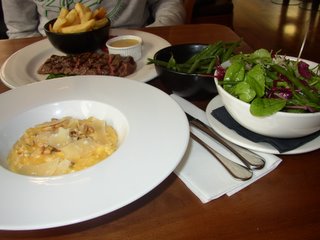Yesterday I spent the day with Eleanor in London. We met at the Tate Britain, where the Turner prize exhibits are better than they have been for years. There's a wonderful & emotional video installation by Darren Almond based on a journey with the artist's grandmother back to Blackpool where she had spent her honeymoon. It is tender, beautiful and profound, time past and time present all in one room. There's also some sensational painting by Gillian Carnegie, including two completely black paintings of a wood, which, as you can see, don't reproduce very well.  Then we moved on to look at the photographs of Roger Fenton, whose pictures of the Crimean war do not show battlefields but logistics, and whose British landscapes are as stunning as the best painting. We traipsed round a couple of the permanent galleries, and, on the way out, I noticed there was a small temporary exhibition of the montage work of John Heartfield, the German communist who consistently criticised the Nazis during the 20s and 30s, and who eventually fled to Britain. There were images I had never seen before (I'm a historian, and Heartfield's work comes up all the time when you're looking at interwar Germany). Powerful stuff.
Then we moved on to look at the photographs of Roger Fenton, whose pictures of the Crimean war do not show battlefields but logistics, and whose British landscapes are as stunning as the best painting. We traipsed round a couple of the permanent galleries, and, on the way out, I noticed there was a small temporary exhibition of the montage work of John Heartfield, the German communist who consistently criticised the Nazis during the 20s and 30s, and who eventually fled to Britain. There were images I had never seen before (I'm a historian, and Heartfield's work comes up all the time when you're looking at interwar Germany). Powerful stuff.
We had lunch at The Ebury in Pimlico Road, which I remember from my 20s when I lived in Pimlico as a scruffy pub. Now it's been thoroughly made over into a chic restaurant, full of slightly terrifying women whose instinct is to boss rather than to nurture. The menu was good, although Eleanor laughed at some of its pretentiousness, especially the notion of crushed potatoes. 
Whatever, the menu lived up to its promise, and I had a very good, smooth pumpkin risotto. Everyone laughed at me for photographing it - the waitress was sneering in an offhand kind of way: "I hope you enjoy eating it as much as looking at it." It's the kind of restaurant where they take the 12.5% service charge without worrying about whether or not they deserve it; I'm still old-fashioned enough to believe that a tip (or, more accurately, the amount of the tip) should be a matter of choice, depending on whether it's been earned.
So, pumpkin risotto for dinner, seeing as there were a couple of butternuts in the veg basket waiting to be eaten. I had to improvise, as all the recipes I read were for risotto with pumpkin chunks. They were also all flavoured with sage, and it was raining, so I didn't want to go out in the dark and wet to pick leaves. All squashes pick up spice flavours well, so I decided on cinnamon.
Gently stew one chopped onion in olive oil. Remove. Stew the diced flesh of one butternut until it's soft. Add a little of this to the onion; process the rest until it's smooth, adding liquid if necessary. Return the onion mix to the pan, add a teaspoon of ground cinnamon, and enough risotto rice for three or four people. Stir, then add some white wine. Boil off the alcohol. Cook the rice by adding small amounts of hot water from the kettle. When the rice is almost done, add the pumpkin puree. Serve with flakes of parmesan, pepper, and toasted pine nuts.
That's what I did, because it's what I had. It would have been improved by the use of stock, but I didn't have any in the fridge, and I no longer use stock cubes because even the best ones are full of things I don't really want to eat. Using water was fine, although it would have been better if I'd gone out into the rain and fetched a couple of bay leaves to liven it up. It would also have been nicer if I'd chopped some parsley into it at the end, and that's what I'll do next time. Despite the limitations, it was good and creamy, with a little bit of bite provided by the onion and squash mix. It would also be good, and much less trouble, without making the puree.






